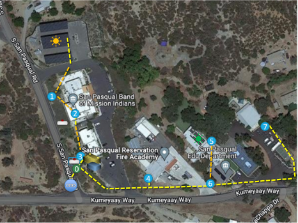Creating Clean Energy Independence
and Reliability for Underserved Communities.
Case study – San Pasqual Band of Mission Indians
More than 75% of the unelectrified homes in the US are located on tribal lands- American Public Power Association.
Tribal communities suffer from higher costs of service, higher interconnection fees, more blackouts and remote or distant service locations. Several tribal communities in California are in both tier-two and tier-three high fire threat zones where Public Safety Power Shut Offs (PSPS’s) are taking place, leaving these communities in the darkness literally.
Power shut-offs by California's major utility companies have pushed the communities to become more energy resilient and rely less on the main power grid.
Why microgrids make sense for Tribal communities?
Microgrid in tribal communities offer local balancing of supply and demand, while also integrating the community as an active part of the energy system.
- Energy reliability: The grid has “control capability,” which means it can disconnect from the larger power grid and operate on its own to generate needed power for emergency services such as police and fire.
- Energy accessibility & affordability: Access to energy at a reasonable cost, when very far from the main grid or totally remote. This also economically benefits the local community by keeping the energy savings within the tribal communities.
- Energy resiliency: In case there’s a public safety power shutoff or an extreme weather event leads to any power outage, the entire community is without electricity for the duration of the event. Tribal microgrids can provide the resilience needed to power critical infrastructure during outages. Tribes are using microgrids to power police, fire and health care facilities.
- Microgrids provide financial, social benefits, improve quality of life, creates local employment opportunities, creates awareness, lowers carbon footprint.

Local sustainable power plant is the answer:
A microgrid is a self-contained power system that supplies electricity to a specific geographic area, such as a college campus, medical complex, shopping mall, or neighbourhood.
One or more types of distributed energy (solar panels, wind turbines, cogeneration, generators) are used to generate electricity within microgrids. Furthermore, many new microgrids have energy accumulators, which are often batteries. Electric vehicle charging stations are also available.
About Gridscape:
Gridscape is the largest and a well-established name specializing in developing and deploying standards-compliant future-proof products and solutions for renewable energy microgrids and fleet charging. Intended to serve as a locally produced sustainable power plant, these microgrids allow sites to become less reliant on the grid by using local sources of energy. They can provide as much as 90% independence from the grid energy, and thus reduce overall energy cost & provide backup clean emergency power during PSPS or other power disruption events. Gridscape with its ‘Product Centric’ approach to microgrids integrated with fleet EV charging solutions allows for lower cost of installation and reduces the time for deployment by substantially lowering integration issues. It expects to deploy and operate over 35 microgrids in California public and commercial facilities over the next 12 months.
Unlike traditional microgrid developers, Gridscape employs a holistic product-centric, artificial intelligence (AI) based software-driven approach to designing, deploying, and managing microgrids. It also integrates Electric Vehicle (EV) charging and other controllable loads into its solution. Through its broad partnerships with various Tier 1 and Tier 2 financiers, design engineering firms, energy storage manufacturers and other renewable energy product providers, it leverages the best-in-class mix of technology and finance to provide maximum return on investment to customers.
Gridscape’s solution is unique, and it differentiates from traditional systems in following manner.
Product Centric Approach (vs Project Centric Methodology) for scalability, maintainability, and longevity of microgrid assets
Software driven architecture resulting into no technology obsolescence and ability to adapt to changing PG&E tariffs and distribution grid conditions.
Dynamically configurable with an ability to change the microgrid operational modes on demand
Energy Information System: A cloud-based distributed energy resource management system (DERMS) that includes
1
Smart AI-based energy management and optimized load and generation dispatch; and
2
Very powerful visualization dashboard for accessing real time and historical data about PV, Storage and EV charging stations.
Inherently Integrated with EV charging infrastructure
Full Energy Management including demand charge reduction, TOU arbitrage, grid services.
Integration with various Cloud platforms such as Google, Amazon for grid services and load management.
Gridscape EnergyScopeTM Dashboards

About the Project

SPBMI is a thriving community of over 1,500 residents. The region, however, is notoriously affected by wildfires and the devastation reaches far beyond the loss of homes and businesses. The community gets hit often due to the reoccurring forest fires and this affects every aspect of life here from power disruption to infrastructural damage. This unreliable power supply here at SPBMI creates an opportunity for a decentralized system; a local sustainable power plant can give resiliency, reliability, savings and above all, safety to the community.
A microgrid will increase the administration’s ability to provide essential services including first response, emergency sheltering, administration command and control.
Furthermore, the project execution and the annual maintenance will be done locally which will create employment opportunities for the tribe and benefit the local economy.
SDG&E has been serving this and few other tribal areas for a long time on an aging 12kV feeder line, which breaks frequently. The SPBMI tribe suffered 180+ hour outages in 2019. The project team includes Gridscape (Lead), Industria Power (EPC), Prosper Sustainably, and a team of many other subcontractors and vendors.
The goals of this project are (A) Economic Cost Savings, (B) Resilience, and (B) Environmental (100% renewables and emissions reduction). The microgrid provides 100% energy and cost offset to the SPBMI tribe.
Microgrid in communities offer local balancing of supply and demand, while also integrating the community as an active part of the energy system.
Benefits of a microgrid:
The project site includes:
- 181kW Solar PV Carport System
- 480kWh Microgrid BESS System
- Gridscape EnergyScopeTM Microgrid Control System
- 6 EV Charging Stations
- 480V/3ph Interconnection with SDG&E on a master meter
- Software-driven Load Control and Management
- Integration with Google Nest Cloud for HVAC load Control
This DOE-sponsored $2.5M project was commissioned in January 2022 and has been operational since then. The project team is waiting for final interconnection approval from SDG&E. Gridscape provided the microgrid technology and EV charging infrastructure. Industria Power was the EPC on the project.
Additional benefits:
- The project will save approx. $78,286 in energy costs annually.
- The project will also offset 112 MT of GHG annually.
- The project will reduce the peak demand and will contribute to additional cost savings.
Innovation
Technical Innovation: This project includes following technical innovations
- Integration with Google Nest Cloud Management System for load control
- EV charging integration with the microgrid
- Single Microgrid Box design to reduce in-field installation and engineering costs
- Replicable, scalable microgrid design
Design
The project will be based on the system design and architecture with minor alterations as shown in following figure.

